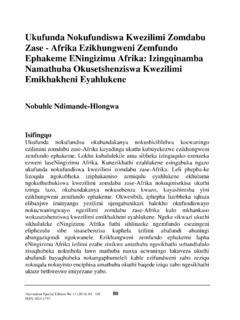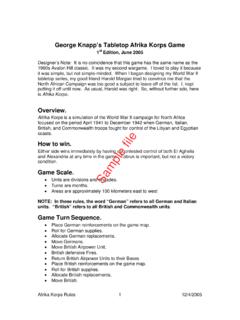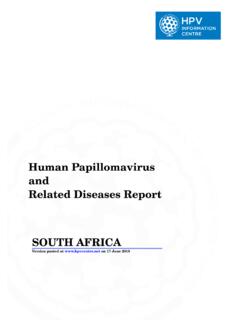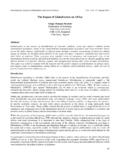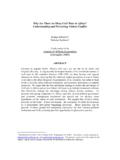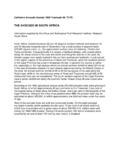Transcription of Africa’s Urbanization: Challenges and Opportunities
1 Maria E. Freire, Somik Lall, and Danny LeipzigerWORKING PAPER NO. 7 Africa s urbanization : Challenges and Opportunities WORKING PAPER NO. 7 Africa s urbanization : Challenges and Opportunities Maria E. Freire, Somik Lall, and Danny Leipziger 2014 The Growth Dialogue 2201 G Street NW Washington, DC 20052 Telephone: (202) 994 8122 Internet: E mail: All rights reserved 1 2 3 4 15 14 13 12 The Growth Dialogue is sponsored by the following organizations: Government of Canada UK Department for International Development (DFID) Korea Development Institute (KDI) Government of Sweden The findings, interpretations, and conclusions expressed herein do not necessarily reflect the views of the sponsoring organizations or the governments they represent. The sponsoring organizations do not guarantee the accuracy of the data included in this work. The boundaries, colors, denominations, and other information shown on any map in this work do not imply any judgment on the part of the sponsoring organizations concerning the legal status of any territory or the endorsement or acceptance of such boundaries.
2 All queries on rights and licenses, including subsidiary rights, should be addressed to The Growth Dialogue, 22 01 G Street NW, Washington, DC 20052 USA; phone: (202) 994 8122; e mail: fax: (202) 994 8289. Cover design: Michael Alwan Africa s urbanization : Challenges and Opportunities iii Contents About the Authors .. v Abstract .. vii Acknowledgments .. ix The Main Idea .. 1 Africa s Urban Expansion .. 4 Alternative Analytical Frameworks: Is urbanization Different in Africa? .. 9 Density without Congestion: Are There Solutions That Are Feasible and Affordable? .. 11 Observations for the Future: As Africa Urbanizes .. 21 References .. 27 Africa s urbanization : Challenges and Opportunities v About the Authors Dr. Maria Emilia Freire is a Senior Advisor at the Growth Dialogue and former Senior Advisor at the World Bank. Dr. Somik Lall is a Lead Economist for Urban Development in the World Bank s Urban and Disaster Risk Management Department.
3 Dr. Danny Leipziger is the Managing Director of the Growth Dialogue and Professor of International Business at the George Washington University School of Business in Washington, DC. Africa s urbanization : Challenges and Opportunities vii Abstract Africa is urbanizing fast. Its rate of urbanization soared from 15 percent in 1960 to 40 percent in 2010, and is projected to reach 60 percent in 2050 (UN Habitat 2010). Urban populations in Africa are expected to triple in the next 50 years, changing the profile of the region, and ch allenging policy makers to harness urbanization for sustainable and inclusive growth. Although many have written about the phenomena, what is clear to us is that is impossible to deal with Africa s growth and poverty Challenges without managing urbanization . urbanization is not a sub plot, but rather the main policy narrative for Africa. Africa s urbanization : Challenges and Opportunities ix Acknowledgments The authors would like to acknowledge the comments of Dr.
4 Maryvonne Plessis Fraissard and Professor Daniel Hoornweg on an earlier version of this paper. Research support from the Institute for International Economic Policy (IIEP) is gratefully acknowledged. Africa s urbanization : Challenges and Opportunities 1 Africa s urbanization : Challenges and Opportunities1 Maria E. Freire, Somik Lall, and Danny Leipziger The Main Idea Africa is urbanizing fast. Its rate of urbanization soared from 15 percent in 1960 to 40 percent in 2010, and is projected to reach 60 percent in 2050 (UN Habitat 2010). Urban populations in Africa are expected to triple in the next 50 years, changing the profile of the region, and ch allenging policy makers to harness urbanization for sustainable and inclusive growth. Although many have written about the phenomena, what is clear to us is that is impossible to deal with Africa s growth and poverty Challenges without managing urbanization .
5 urbanization is not a sub plot, but rather the main policy narrative for Africa. Africa s urban growth is in line with the trends observed in most emerging and developed countries. In the last 10 years, the region s economies grew rapidly above 5 percent a year (IMF 2012) and the outlook for the near term is largely positive. Findings from economic geography tell us that density is needed for economic prosperity and that urban growth is a necessary condition for accelerated growth and shared prosperity (World Bank 2008; Henderson 2005, 2010; Venables 2010). Long run growth needs an efficient system of urban centers that produce industrial goods and high value services, along with transportation networks to link national economies with regional and global markets (Spence et al. 2009; World Bank 2009). Along the broad spectrum of development patterns, Africa urbanization presents some peculiarities.
6 While the heterogeneity of the region precludes easy generalizations, one can take note of some 1 This working paper has been accepted for publication in J. Y. Lin and C. Monga, eds, The Oxford Handbook of Africa and Economics, Volume 1: Context and Concepts, New York, Oxford University Press (forthcoming, 2015). All future rights reserved. 2 Maria Freire, Somik Lall, and Danny Leipziger singular characteristics. Although Africa and Asia have similar urban rates (around 40 percent), per capita GDP in Africa was one third that of Asian countries in 2012. In addition, Africa s literacy rates and institutional development indices are much lower than Asian counterparts, and Africa s infrastructure lags behind. Recent population censuses are providing more accurate data than has been available in the past. Among other issues, this new information will shed light on such questions as (a) the size and source of urban growth across African countries (Potts 2012; Gollin et al.)
7 2013); (b) the role of rural migration versus natural growth in urban expansion (Fox 2012); and (c) the usefulness of growth models in explaining the long term pattern of urbanization . The typical models of structural transformation explain urban expansion through the movement of labor from rural to urban areas that follow the transformation from agriculture to industry and services. urbanization would be a result of either a push from agricultural productivity growth or a pull from industrial productivity growth leading to production cities, with a mix of workers in tradable and non tradable sectors. However, this model of development does not seem to explain the urbanization pattern of more than a dozen African countries those whose economic growth has been associated with natural resource exploitation but not with increased manufacturing shares of GDP (Collier 2009; Gollin et al.
8 2013). In these countries, urbanization is likely to have been driven by the income effect of natural resource endowments. Assuming that tradable goods are more li kely associated with increases in productivity than non tradable goods, the lack of manufacturing development could hinder long run economic potential for African cities. This argument merits further empirical research. Understanding African urbanization is highly relevant in other domains as well. Extreme poverty continues to be more prominent in rural than in urban areas (at least three times higher). Therefore, urbanization would seem to be a superior way to provide better services and livelihoods to millions, as well illustrated in the case of China (Taylor 2008). One may expect that over time, the gap between urban and rural earnings will decline and eventually disappear, as surplus labor shrinks and the rural sector modernizes.
9 But it be quite a while Africa s urbanization : Challenges and Opportunities 3 until this As part of the process, one might stress the importance of governments providing basic services to smaller cities and intermediate towns that can facilitate the transition between rural and non rural activities (Ferre et al. 2010), the mobility of labor, and the generation of economic activity. As in most developing countries, urbanizing Africa will face serious Challenges , especially as policy structures adjust slowly (Henderson 2005). At the national level, integration of capital markets often occurs more slowly than labor market integration, which is facilitated by migration. Investment in infrastructure is woefully inadequate, institutional development lags, and the fiscal base is weakened by centralized processes. Urban management and planning needs to be strengthened to help cities plan ahead and avoid congestion, pollution, and the emergence of urban slums; but the track record of most African countries in this arena is poor so far.
10 For this reason, the issue of urban management is at the core of the continent s development challenge. This paper addresses the question of what is required to make African cities efficient, sustainable, and inclusive. We will be using economic geography as an organizing framework (World Bank 2008; Henderson, 2005; Venables 2010) for policy recommendations that support agglomeration benefits while managing co ngestion costs. The paper is organized in five sections. The first shares key elements on African urbanization . The second section reviews recent literature on urban growth models and how these models apply to Africa s urbanization process. The third and fourth sections discuss what it will take to encourage efficient and inclusive African cities, while taking into account the diversity of countries and the geographical and social division of the continent. Section five closes with key conclusions and observations for the future.
